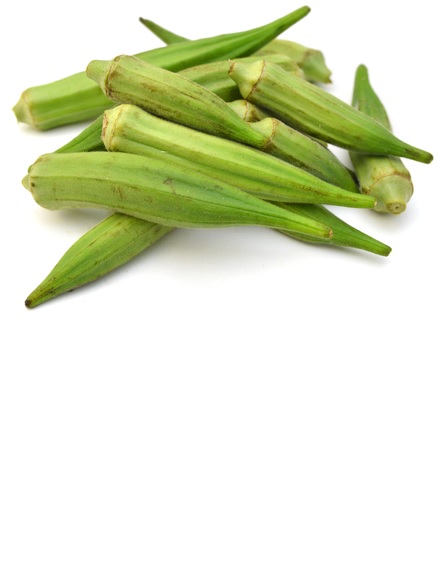 Growing Okra - April 29, 2015 Jeff Schalau, Agent, Agriculture & Natural Resources University of Arizona Cooperative Extension, Yavapai County Okra is a very attractive plant related to Hibiscus and cotton. Wild okra originated in the Nile Valley. Its cultivation by Egyptians began in the 12th Century BC. From there, okra spread throughout Africa, the Mediterranean, the Balkans, and India. It arrived in the Americas (Brazil) in the 1600's, and then spread northward to New Orleans reaching Philadelphia in 1781. Okra grows best on loams and sandy loam soils, but will produce good yields on heavier soils. However, it does not tolerate excessive moisture or poorly aerated soils. Prepare soil as you would for annual crops by incorporating composted organic matter and balanced fertilizer (2-3 pounds of 10-20-10 per 100 sq. feet or equivalent) before planting. And now for the good news: okra prefers a soil pH above 6.0 (most of our soils are pH 7.5 to 8.5). Okra is best grown from seed since it is fairly quick to produce fruit (48 to 55 days after emergence). Okra seed does not store well so, buy fresh seed each season, or save seed of non-hybrid varieties yourself by allowing a few pods on your best plant to mature. Varieties recommended by Texas A & M are ‘Lee’, ‘Emerald’, and ‘Clemson Spineless’. These varieties reach heights of 5 to 6 feet when mature. A dwarf variety is ‘Dwarf Green Long Pod’ which reaches a mature height of 3 feet. ‘Annie Oakley is also a compact plant with extra tender pods. Okra thrives after soils have warmed and nighttime temperatures are above 50 degrees F. For best results, plant in spring 2-3 weeks after all danger of frost has passed. For a good fall crop, plant at least 3 months before first fall frost. Probabilities for these frost dates are available on the Yavapai County Cooperative Extension web site (ag.arizona.edu/yavapai/) under Natural Resources of Yavapai County. Otherwise, the first of June is a safe planting date. Plant okra near other tall crops or on the north end of the garden to avoid shading out other crops. Sow seeds about 2 inches apart and 1 inch deep. Rows should be at least 3 feet apart if you want to walk in between rows. Thin plants to one foot apart after they are up and growing. Okra can tolerate dry soil. However, regular irrigation will increase yields. Keep the area weed free and apply a light fertilization following the first harvest. Harvest pods when they are tender and immature (3-4 inches long). They must be picked every other day to maintain production. Use shears to cut pods from plant. If the stem is difficult to cut, then the pod is probably too tough to use. However, do not allow old pods to remain on the plant as these will sap energy reducing production. Refrigerate dry, unwashed okra pods in the vegetable crisper loosely wrapped in breathable plastic bags (like the ones used in supermarkets). Okra can be stored in the refrigerator for 2-3 days for fresh use. Once pods begin to darken, they should either be used or discarded. Okra pests include aphids, stink bugs, and cabbage loopers. Aphids can be washed off with a steady stream of water or sprayed with soap spray. Stink bugs are more difficult to control. These can be hand-picked and destroyed or treated with Sevin (carbaryl) if you choose to use a pesticide. Cabbage loopers can be controlled with Bt (Bacillus thuringiensis). Note: pesticides should only be applied when damage to the crop is significant. Okra is very nutritious. About half of the okra pod is soluble fiber in the form of gum and pectin. Soluble fiber helps to lower serum cholesterol, reducing the risk of heart disease. The other half is insoluble fiber, which helps to keep the intestinal tract healthy. Okra gives soups and stews smoothness and adds thickness. Of course, if it is breaded and fried, you will probably just break even. Admittedly, I was not a fan of okra until I visited Louisiana and Mississippi many years ago. While there, I had fried okra and gumbo several times. This was enough to allow me to overlook okra's slimy reputation and begin enjoying it. I have included additional resources below. Follow the Backyard Gardener on Twitter – use the link on the BYG website. If you have other gardening questions, call the Master Gardener help line in the Camp Verde office at 928-554-8999 Ext. 3 or e-mail us at verdevalleymg@gmail.com and be sure to include your name, address and phone number. Find past Backyard Gardener columns or provide feedback at the Backyard Gardener web site: http://cals.arizona.edu/yavapai/anr/hort/byg/. Additional Resources Watch Your Garden Grow: Okra University of Illinois Extension urbanext.illinois.edu/veggies/okra.cfm Easy Gardening: Okra Texas A & M AgriLife Extension aggie-horticulture.tamu.edu/vegetable/files/2010/10/E-513_okra.pdf Home Gardening Series: Okra University of Arkansas Cooperative Extension Service www.uaex.edu/publications/PDF/FSA-6013.pdf |